Azerbaijan Medicine Museum | |
 | |
 | |
| Established | 1986 |
|---|---|
| Location | Baku, |
| Coordinates | 40°23′00″N49°52′37″E / 40.383438°N 49.876953°E |
The Azerbaijan Medicine Museum is a museum in Baku, Azerbaijan that covers the history of medicine.
Azerbaijan Medicine Museum | |
 | |
 | |
| Established | 1986 |
|---|---|
| Location | Baku, |
| Coordinates | 40°23′00″N49°52′37″E / 40.383438°N 49.876953°E |
The Azerbaijan Medicine Museum is a museum in Baku, Azerbaijan that covers the history of medicine.
The museum was created by the decree of the Ministry of Health of the Republic of Azerbaijan (Minister Talat Gasimov) dated July 2, 1984.[ citation needed ] It has officially been operating since January 29, 1986. [1]
The exhibits begins with the bas-relief, which is a description of Asclepius (a hero and god of medicine in ancient Greek religion and mythology). At the entrance, Asclepius and his daughters, Hygieia and Panacea have huge bas-reliefs.
In the first hall, a bust of Abu Ali ibn Sina, one of the greatest scholars of the 12th century in the East and the photo of the manuscript of the Law of the Science of Doctor work written in 1143, which is being taught in many European medical universities are illustrated. This hall also features a bust of Hippocrates, who is the founder of modern medicine, and a piece of his famous oath. Different elements of ancient Greek and Roman, medieval Azerbaijan, Eastern, Western European medicine have been embedded to copper boards along the walls. [1]
The second hall features medieval surgical instruments, copies of separate medical records of 13th to 19th centuries which the original ones are kept in the Manuscripts Institute. Portraits, diplomas, monographs, and dissertations of the first Azerbaijani doctors studied in the European and Russian universities in the 19th century, Abdulkhalik Akhundov, the organizer of the first free medical treatment in Baku Mammadrza Vakilov, the first sanitary doctor Mustafa Sharifov, Bahram Akhundov, Karimbey Mehmandarov, Ibrahim Rahimov, are displayed in this hall. There is also a corner dedicated to the scientist, professor of Kazan (Volga region) Federal University Mirza Kazim Bey, who enriched nerve and cardiology fields with scientific experiments. [2]
The third hall covers the beginning of the 20th century in Baku. According to the decision of the oil industrialists, many photographs and documents relating to the creation of medical facilities equipped with modern medical equipment were demonstrated.
In the fourth hall, Comprehensive information has been provided about the medicine during the period of the first democratic republic of the East-Azerbaijan Democratic Republic, the first building of Baku State University, founded in 1919, its first rectors, Vasili Razumovsky and neuropathologist Sergey Davidenko, the first graduation of the medical faculty, professors and teachers. Here, in the early years of Soviet power in Azerbaijan, the activities of the Revolution Committee in health care are widely discussed, medical magazines published in Baku, works of scientists and other materials are exhibited. [2]
One of the corners of the hall has been dedicated to Nariman Narimanov. His medical articles, his personal belongings, and the letter written by him to his son Najaf, are displayed here.
In the fifth hall, prior to the war,[ which? ] a great attention was paid to the organization of healthcare in the Soviet Azerbaijan, the establishment of the Azerbaijan Medical University and the Doctors Improvement Institute.
The Azerbaijan Red Crescent Society has its first recognition marks and clothes.
The last hall of the museum is about the work done in the field of health under the leadership of the President of the Republic of Azerbaijan Ilham Aliyev. [2]
Baku Slavic University (BSU) is a public university located in Baku, Azerbaijan.

Azerbaijan Medical University named after Nariman Narimanov is the formal name of the public medical school located in Baku, Azerbaijan. Due to difficulties with translation, the school is sometimes called: Azerbaijan Medical University, Azerbaijan State Medical University, Azerbaijan State Medical Institute, or simply Medical University, with any of the preceding including the "named after N. Narimanov" or full "Nariman Narimanov". The school is named after Nariman Narimanov, a famous Azerbaijani in Soviet politics, notably party chairman of the Central Executive Committee of the Soviet Union.
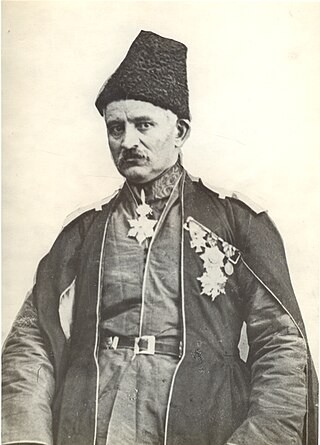
Mirza Fatali Akhundov, also known as Mirza Fatali Akhundzade, or Mirza Fath-Ali Akhundzadeh, was a celebrated Iranian Azerbaijani author, playwright, atheist, philosopher, and founder of Azerbaijani modern literary criticism, "who acquired fame primarily as the writer of European-inspired plays in the Azeri Turkic language".
The National Library of Azerbaijan, officially named the Mirza Fatali Akhundov National Library of Azerbaijan after Mirza Fatali Akhundov, is the national library of the Republic of Azerbaijan, located in Baku and founded in 1923. It is named after Mirza Fatali Akhundov, an Azerbaijani dramatist and philosopher. The library is located on Khagani Street and overlooks Rashid Behbudov Avenue and Nizami Street. Its façades feature the statues of various writers and poets: Nizami Ganjavi, Mahsati, Uzeyir Hajibeyov, Shota Rustaveli, Alexander Pushkin and several others.

Aziz Mammad Karim oghlu Aliyev was an Azerbaijani, Dagestani, and Soviet politician, scientist, and member of the Supreme Soviet of the USSR. He was the father-in-law of Azerbaijan's President Heydar Aliyev, who married his daughter Zarifa Aliyeva, and maternal grandfather of Azerbaijan's current President Ilham Aliyev and brother of Shamama Alasgarova, who was famous Azerbaijani doctor.

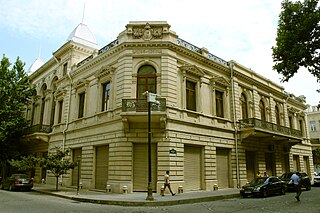
The National Museum of History of Azerbaijan is the largest museum in Azerbaijan. It is located in Baku, in the former residential house of Azerbaijani oil magnate and philanthropist Haji Zeynalabdin Taghiyev. The museum was founded in 1920, following the Russian takeover of Baku, and opened to visitors in 1921.

The National museum of Azerbaijan literature named after Nizami Ganjavi is a museum in Baku, established in 1939. It is located near the entrance of Icheri Sheher, not far from the Fountains Square. The museum is considered one of the greatest and richest treasuries of Azerbaijani culture.
Azerbaijani art is the art created by Azerbaijanis. They have created rich and distinctive art, a major part of which is applied art items. This form of art rooted in antiquity, is represented by a wide range of handicrafts, such as chasing (metalworking), jewellery-making, engraving, carving wood, stone and bone, carpet-making, lacing, pattern weaving and printing, and knitting and embroidery. Each of these decorative arts is evidence of the culture and the abilities of the Azerbaijan nation, and are very popular there. Many interesting facts pertaining to the development of arts and crafts in Azerbaijan were reported by merchants, travellers and diplomats who visited these places at different times.
Vali Yusif oghlu Akhundov, also spelled as Vali Akhundov, was the 10th First Secretary of Azerbaijan Communist Party, politician and scientist.
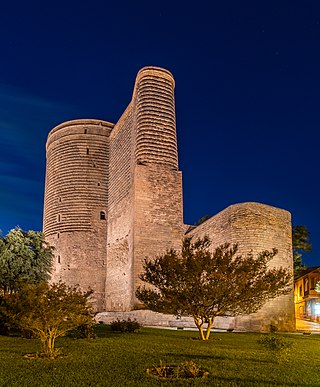
The architecture of Baku is not characterized by any particular architectural style, having accumulated its buildings over a long period of time.

The Palace of Happiness, currently also called Palace of Marriage Registrations and previously called Mukhtarov Palace, is a historic building in the center of Baku, Azerbaijan, built in Neo-Gothic style in the early 20th century.
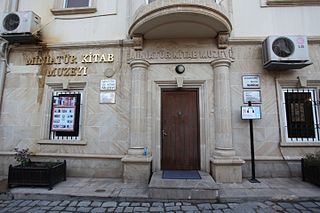
The Baku Museum of Miniature Books is the only museum of miniature books in the world, settled in the old part of Baku, called Inner City. The museum started its operation on April 2, 2002. In 2015 the Museum of Miniature Books was presented the Certificate of the Guinness Book of Records as the largest private museum of miniature books.

The Independence Museum of Azerbaijan or "Istiqlal" Museum – is a museum established on 7 December 1919 in Baku – the capital of the Azerbaijan Democratic Republic. H. Mirzajamalov and I. M. Aghaoglu had a great role in creation of the museum. Archeological finds, exemplars of rare books, objects of numismatics, jewelry, etc. were collected in the museum.
Medicine in Azerbaijan serves to protect the health and prosperity of citizens of the Republic of Azerbaijan. Reforms in the sphere of medical care and the health care system's direction are parts of a global strategic development program of economic and social infrastructure. This program is based on principles of the establishment of a high-life democratic society with a market economy.
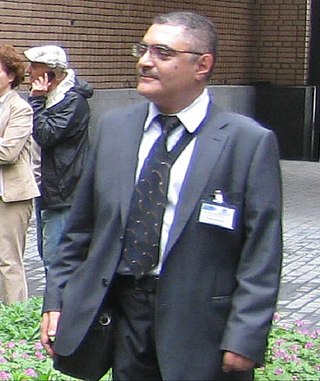
Farid Alakbarli was an Azerbaijani scholar, PhD and professor in history, specialist in the field of history of science, culturology, and medieval medical manuscripts, the head of Department of Information and Translation of the Institute of Manuscripts of the Azerbaijan National Academy of Sciences, president of the Azerbaijan Association of Medical Historians (AAMH), National Delegate from Azerbaijan to International Society for the History of Medicine (ISHM), author of more than 200 scientific and educational works including 23 books and booklets in Azeri Turkish, Russian, English, German and Italian.

Healthcare in Azerbaijan is provided by public and private healthcare institutions and regulated through the Ministry of Healthcare.

Abulfaz Faraj oghlu Garayev, also spelled as Abulfaz Qarayev, was the first Azerbaijani pediatrician, honored scientist of Azerbaijan.

Musa Mirmammad oglu Abdullayev (27 November 1927, Masallı district, Azerbaijan SSR, USSR — 8 August 1979, Baku, Azerbaijan SSR, USSR) — Prominent hematologist of Azerbaijan, doctor of medicine, professor, philologist-translator. He was one of the eight members of the anti-Soviet nationalist student-youth political organization "Lightning" (İldırım), formed for the independence of Azerbaijan within 1942-1944.
Sona Vəlixan, was an Azerbaijani Soviet ophthalmologist, doctor of medical sciences, professor, Honored Scientist of Azerbaijan SSR (1942), and the first Azerbaijani woman to receive a medical degree. She played an important role in the development of Azerbaijani ophthalmology.